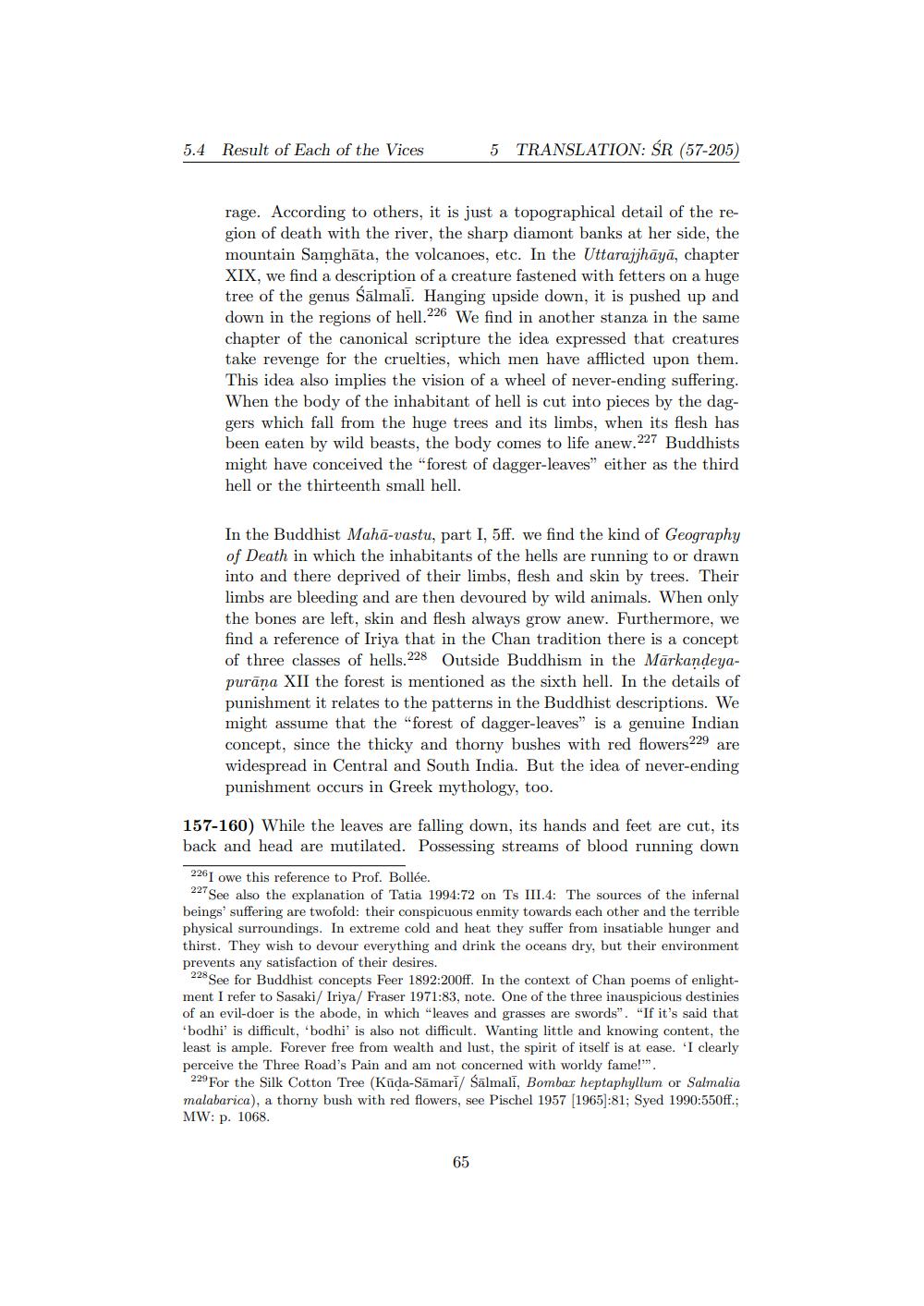________________
5.4 Result of Each of the Vices
5 TRANSLATION: ŚR (57-205)
rage. According to others, it is just a topographical detail of the region of death with the river, the sharp diamont banks at her side, the mountain Samghāta, the volcanoes, etc. In the Uttarajjhāyā, chapter XIX, we find a description of a creature fastened with fetters on a huge tree of the genus Sālmali. Hanging upside down, it is pushed up and down in the regions of hell.226 We find in another stanza in the same chapter of the canonical scripture the idea expressed that creatures take revenge for the cruelties, which men have afflicted upon them. This idea also implies the vision of a wheel of never-ending suffering. When the body of the inhabitant of hell is cut into pieces by the daggers which fall from the huge trees and its limbs, when its flesh has been eaten by wild beasts, the body comes to life anew.227 Buddhists might have conceived the "forest of dagger-leaves" either as the third hell or the thirteenth small hell.
In the Buddhist Mahā-vastu, part I, 5ff. we find the kind of Geography of Death in which the inhabitants of the hells are running to or drawn into and there deprived of their limbs, flesh and skin by trees. Their limbs are bleeding and are then devoured by wild animals. When only the bones are left, skin and flesh always grow anew. Furthermore, we find a reference of Iriya that in the Chan tradition there is a concept of three classes of hells.228 Outside Buddhism in the Markandeyapurāņa XII the forest is mentioned as the sixth hell. In the details of punishment it relates to the patterns in the Buddhist descriptions. We might assume that the forest of dagger-leaves" is a genuine Indian concept, since the thicky and thorny bushes with red flowers 229 are widespread in Central and South India. But the idea of never-ending punishment occurs in Greek mythology, too.
157-160) While the leaves are falling down, its hands and feet are cut, its back and head are mutilated. Possessing streams of blood running down
226I owe this reference to Prof. Bollée. 227 See also the explanation of Tatia 1994:72 on Ts III.4: The sources of the infernal beings' suffering are twofold: their conspicuous enmity towards each other and the terrible physical surroundings. In extreme cold and heat they suffer from insatiable hunger and thirst. They wish to devour everything and drink the oceans dry, but their environment prevents any satisfaction of their desires.
228 See for Buddhist concepts Feer 1892:200ff. In the context of Chan poems of enlightment I refer to Sasaki/ Iriya/ Fraser 1971:83, note. One of the three inauspicious destinies of an evil-doer is the abode, in which "leaves and grasses are swords". "If it's said that 'bodhi' is difficult, bodhi' is also not difficult. Wanting little and knowing content, the least is ample. Forever free from wealth and lust, the spirit of itself is at ease. 'I clearly perceive the Three Road's Pain and am not concerned with worldy fame!'".
229 For the Silk Cotton Tree (Kūda-Sāmari/ Sālmali, Bombar heptaphyllum or Salmalia malabarica), a thorny bush with red flowers, see Pischel 1957 [1965]:81; Syed 1990:550ff.; MW: p. 1068.
65




